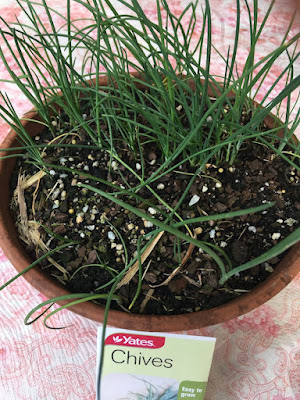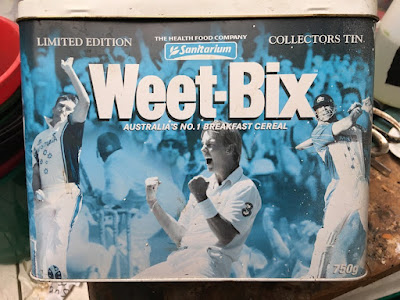Sow some seeds
Spring is the ideal time to sow seeds of so many delicious crops, such as all salad greens, tomatoes, shallots, basil, silver beet, carrots, eggplant, cucumbers, zucchini — there are countless others — and the good news if you are locked down is that major supermarkets often stock the seeds you are looking for. I bought my Yates seeds for these babies pictured below at my local Woolies supermarket.
 |
| On the left are some shallot seedlings enjoying the morning sun, while on the right are seedlings of "mesclun" salad greens, which is a mixture of different greens. After sowing the seeds the fastest ones – the rocket (or arugula) – came up in just four days. The slowies took two weeks. The shallot seedlings came up in 7 days, so on each and every morning I was out there misting the seedling trays with water, there was something new coming up. |
 |
| After about three weeks the seedlings are ready for more sunshine, so in my garden a lovely half-way house is under the dappled shade of my potted Thai lime tree. The seedlings get a bit of direct sun on them during the day but big brother lime tree shades them most of the time. In two weeks from now, they'll all be much bigger and potted up in their troughs in full sun, ready to roar away as spring warms up. |
Sowing seeds is a bit hit and miss sometimes, but I find I get 10 hits to every miss, so give it a go, the odds of succeeding are really good.
Salad greens like mesclun, rocket, lettuce etc are very reliable and worth a try.
Basil is a good bet once the weather becomes truly warm.
If you're nervous about tomatoes give cherry tomatoes a try.
And if you want to fire up your lifestyle, chillies are so much fun to grow from seed. So many types and, given you probably only need one or two plants of each variety to knock your socks off, you're bound to have lots of success.
Go potty
Spring is a good time to do a bit of repotting. Here's one simple job I did this week, part of my succulent and cactus patch renovation.
 |
| God knows how many years ago, these three were tiny, cute midgets in baby pots that could sit on a windowsill. So I put all three in the one pot, put it out in the garden and forgot about them – and my, haven't they grown. Time for an upgrade in accommodation. |
 |
Half an hour later each plant has its own home, and if I manage to neglect them for the next decade they'll probably need an upgrade in size by then. Without repotting, each plant would have crowded the other and all three would have suffered and probably died in the end.
This way, all three will just keep on growing. |
So if you have a single plant that has grown too big for its pot, or you have too many plants in the one container, do everyone a favour and remove all the plants from the pots, upgrade their accommodation, and they'll be with you for many years to come.
Renovate your compost bin
Smelly compost? Open the lid and a cloud of little flies swarms out? Chances are your compost is too wet. What it needs is more dry matter to balance things out. And for me, the easiest source of dry matter is my big bag of sugar cane mulch.
So I've been adding a few generous handfuls of mulch to my tumbler compost bin, giving the lot a twirl so it all mixes up nicely, then adding some more mulch a few days later.
If, like me, your kitchen fruit and vegie scraps bin is the main source of new materials for your compost bin, your compost bin is in danger of being too wet. When that happens composting slows down and things can get smelly. Add some dry matter (raked up autumn leaves if you have any), but if you have a bag of mulch, it's the easiest and quickest way to get your compost bin back in business.
Feed everything!
Spring is fertilising time, so get out there and do it. Doesn't matter what you use, usually, but there are so many specialist types of fertiliser to choose from it's easy to become overwhelmed with choice.
The only plants you need to be extra-careful with are natives, and they definitely need specialist native-friendly food that won't harm them but will feed them. The good news is there are many native friendly plant foods around now.
The best rule to follow, apart from reading the instructions on the packs, is that it is much much better to under-fertilise than overdo it. More is not better with fertiliser. So treat the maker's recommended dosages as the "maximum" dose at all times, and there's nothing wrong with lighter, half-dosage feeds, either.
To keep things simple I mostly just use a liquid food (mixed up in a watering can) for all my edibles. Leading brands such as Dynamic Lifter, PowerFeed, Charlie Carp all do the same kind of job, and there are several others in the same category. In the growing season (ie, now) I liquid feed crops once a fortnight.
For most of my potted plants I use slow-release fertilisers, brands such as Osmocote and PowerFeed leading the field. These are almost "set-and-forget" in that you apply the little pellets, then you don't need to re-apply for months after that. Read the instructions and you'll see that some last 3 months, others 6 months. That's about it.
And for general garden use and feeding citrus trees I use organic-based pellets such as Dynamic Lifter. The good thing about chicken poo style fertilisers and other organic-based products is that they also feed everything that lives in the soil, not just the plants.
Compost is a fabulous fertiliser for feeding the whole of the soil, so is blood and bone. Seaweed is a superb soil health tonic too.
All the pure organic, or organic-based fertilisers are the best long-term option for improving the overall health of your garden soil. The benefits don't happen overnight, but over the years they are the outstanding option.
 |
| So get out in the spring sunshine, plant some crops, visit your growing babies each day to care for them, then start harvesting the organic home-grown goodness that you've raised yourself. It's a satisfying feeling in a trying time. Give it a try. |





















































